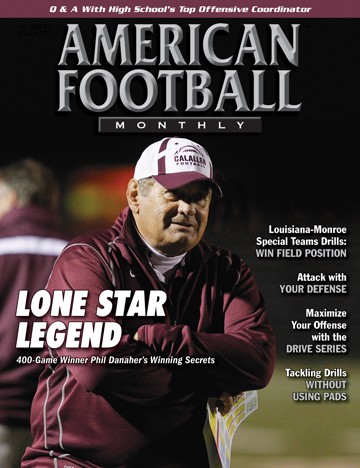Article CategoriesAFM Magazine
|
Leadership Strategies: In Need of a New Directionby: Josh Hood and Justin PoncyOffensive Line Coach Park Hill High School (MO) © More from this issue Coaching staffs should not expect seniors to lead simply based on their age. So, the ultimate goal of our program became to build better men, to help them to grow individually, and eventually teach them how to lead other young men. The result of our emphasis on leadership has been impressive. In 2014 we had a 13-game winning streak that included a #1 Missouri state ranking, a top 150 national ranking, and a narrow defeat in the Class 5 State Semifinals. In the offseason, one of our coaches decided to teach character lessons to our players on a weekly basis. Based on his success, our staff agreed to move our practice schedule back 15 minutes daily. This would allow for a short meeting between our players and coaches every day after our practice film session and prior to our work on the field. These player-led discussions focused around developing character and teaching leaders through a series of lessons and mini-projects where the athletes would complete. The second thing we did was to implement a new policy that would give back to our community. Led by a couple of driven seniors last season, our program adopted a policy where each player participates in at least one community service project prior to the first practice of the fall. Team members work in small groups giving back to our neighbors and community. Projects include working in a soup kitchen, volunteering at our local coat closet, cleaning out an animal shelter, offering to help move an elderly member of the community, or working a youth football camp. The third piece of this rehabilitation program was to create a small group of players the coaching staff could teach leadership concepts to use throughout the entire program. This group assumed a role outside that of simply playing football. This collection of leaders would become a part of the solution, serving not only as a governing body, but ideally a model of integrity for the entire program to follow. One responsibility of the council is to listen to both coaches and players. The council provides the team with an open forum by which players may communicate not only with each other, but with coaches as well. The council also establishes punishments for minor player offenses. In 2014, I witnessed a variety of player conversations and daily conditioning reminders initiated by the Leadership Council and its individual members. The group took on the role of a judicial branch, which completely took that burden off the coaches themselves. Another purpose of the Leadership Council is to make decisions regarding such things as game day attire, weekly planning and organization, and offseason gatherings. These decisions provide the players a chance to put their own “stamp” on each season. The coaching point here is that when individuals feel they are a valued member of the team, they will invest more deeply in the success of the program. Players took part in choosing the helmet decals, new uniform changes, and summer conditioning schedule. The Leadership Council also runs player meetings and passes down the lessons of leadership and positive decision making on the youth of our program. These leaders run our daily character building sessions and address the team before or after games and practices as needed. This vocal leadership, much like many of the football fundamentals coaches teach every day, is often not instinctive. More often this is a learned skill from the lessons provided by our program and the coaches modeling the proper behavior and reactions of leaders. The Leadership Council is an idea that is constantly changing to adapt to the program, the community, and the needs of our players and coaches. Most importantly, our athletes have accepted that games are not won in the fourth quarter by one particular screen play or halfback pass, but instead by the daily teachings of leaders and the ability of these influential members of our football team to leave the program in a better position than they found it. |
|
| HOME |
MAGAZINE |
SUBSCRIBE | ONLINE COLUMNISTS | COACHING VIDEOS |
Copyright 2026, AmericanFootballMonthly.com
All Rights Reserved




